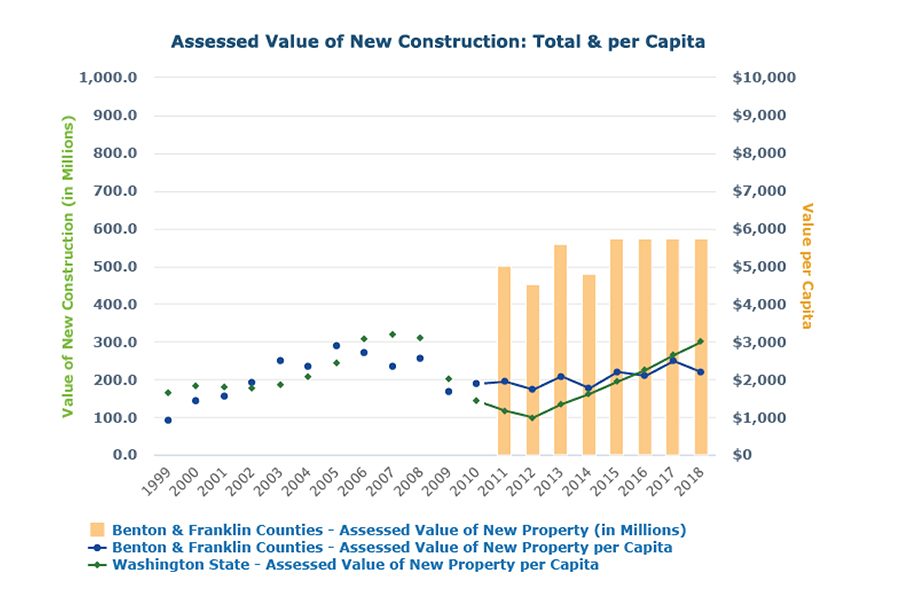
Home » Tri-City construction pulse beat strong, but what now?
Tri-City construction pulse beat strong, but what now?

April 14, 2020
Humans have shown a need to build since the dawn of time as hunter-gatherers. That need accelerated as our ancestors organized into agricultural societies. Monumental reminders are still with us, such as pyramids in both hemispheres and the Great Wall. More modest reminders come from archeologists’ digs across the globe.
From an economic perspective, construction is a human endeavor that delivers both immediate economic activity and long-lived assets. Think of what homes, commercial structures, roads, factories and bridges represent. The process of creating them provides immediate jobs and payroll, then a flow of benefits that typically last decades. Construction also brings strong indirect effects from the supply chain, at least at the state or national level. Consequently, it’s no surprise that tracking construction activity offers insight into the state of the overall economy.

Construction typically lands among the largest sectors of local economies. In 2018 in Benton and Franklin counties, it ranked eighth by headcount, with average annual employment of nearly 8,800. In the eyes of labor economists, it is made up of three subsectors: building construction (general contractors), specialty trades and to a lesser extent, heavy and civil construction (highways and infrastructure).
For much of the past decade, construction activity in Benton and Franklin counties has been on a tear. This is clearly visible looking at the assessed value of new construction. For the most recent available year, 2018, the total amounted to $633 million. That was the third-highest result on record for the regional economy, with 2017 claiming the peak ($705 million).
The value of new construction in the greater Tri-Cities in 2018 placed only a little higher than a decade ago. The runup years to the Great Recession of 2008-09 were, of course, generous to the construction sector. And the decline was swift. So the 2018 value represents a big increase from the deep trough that occurred in 2009, $412 million.
To facilitate comparisons, the chart’s data also shows a related trend, per capita value of new construction (blue and green lines). As we can readily observe, for much of the past decade the value of local new construction expressed in this manner outpaced that of the state. The most recent three years, however, depict that the pace of construction activity here slipped a bit relative to Washington, especially in 2018.
Part of the recent diverging paths between the greater Tri-Cities and the state’s construction activity lies in the definition of the ratio. Population is in the denominator. And population here has grown about 50 percent faster than the state average over the past decade! So, it’s no surprise that the ratio for the two counties would shade lower than that of the state.
The consequences of strong construction growth are all happy ones, from an economic perspective. First and foremost, jobs are created. Over the decade 2008-18, the construction sector produced over 1,850 new jobs. This placed it third among all sectors of the greater Tri-Cities economy for total job creation, after health care and social assistance, and hospitality. Ranked by percentage growth, construction placed first, with a cumulative rate of 38 percent. That increase is about twice as large as the overall job growth rate in the two counties.
Currently, the relative size of the construction sector in the greater Tri-Cities lies well above its counterparts in metro areas of Eastern Washington. In 2018, those about 8,800 construction jobs in the greater Tri-Cities amounted to 7.1 percent of the workforce. Contrast that share to the immediately adjacent counties, where construction jobs took up 3.3 percent of the workforce in Yakima County and 3.1 percent in Walla Walla County. Further north, construction was a little more dominant, as it claimed 5.4 percent of the workforce in Spokane County and 4.5 percent in the greater Wenatchee area. Still, these are well below the share here.
To what degree this outsized position of construction is due to the Hanford cleanup is unknown. But according to regional labor economist Ajsa Suljic, most of those workers fall into a different sector. It appears that the main driver of so many construction jobs is simply the outsized population growth in the greater Tri-Cities. Of course, the billions of dollars spent at Hanford have driven, in turn, population increases.
And what might the rest of the year here hold? A longer-term question concerns the second half of this year and into 2021. If the economic recovery here and in the state doesn’t follow a “V-shaped” pattern, then the pace of construction growth will drop off, and perhaps turning negative.
Here’s to the future reward for physical (but not social) distancing—for this sector and for all of the greater Tri-Cities.
Patrick Jones is the executive director for Eastern Washington University’s Institute for Public Policy & Economic Analysis. Benton-Franklin Trends, the institute’s project, uses local, state and federal data to measure the local economic, educational and civic life of Benton and Franklin counties.
Real Estate & Construction Local News
KEYWORDS april 2020




